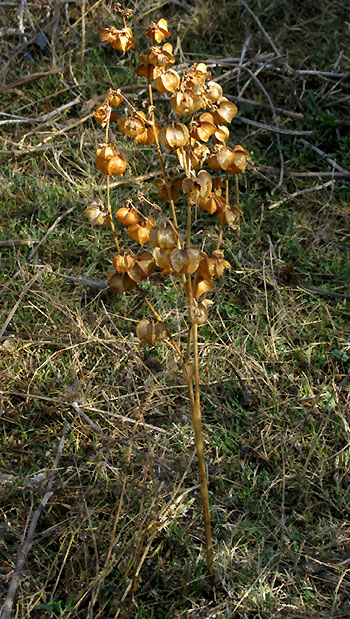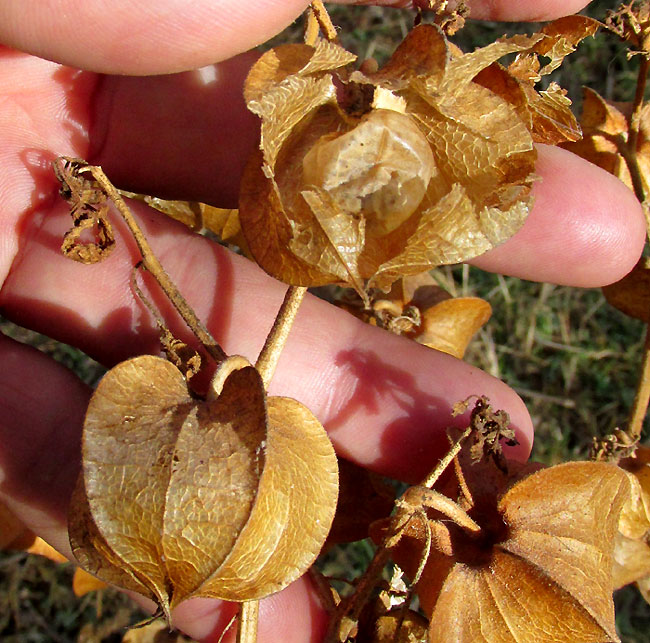Excerpts from Jim Conrad's
Naturalist Newsletter
entry dated February 15, 2023, issued from near Tequisquiapan, elevation about 1,900m (6200 ft), Querétaro state, MÉXICO
(~N20.55°, ~W99.89°)
HUSK TOMATO IN THE DRY SEASON
 Here during the dry season when much of the landscape is parched gray, as shown in the background at the right, a lone, robust-looking, meter-high (3.3ft) fruiting head, or infructescence, was very eye-catching, and a pleasing thing to see. It grew on the frequently sheep-grazed, grassy floor of a shallow, usually dry ravine, or barranca. The structure of the dead plants' unusual and very distinctive Chinese-lantern-like fruits can be seen below:
Here during the dry season when much of the landscape is parched gray, as shown in the background at the right, a lone, robust-looking, meter-high (3.3ft) fruiting head, or infructescence, was very eye-catching, and a pleasing thing to see. It grew on the frequently sheep-grazed, grassy floor of a shallow, usually dry ravine, or barranca. The structure of the dead plants' unusual and very distinctive Chinese-lantern-like fruits can be seen below:

At the picture's top, one side of a bladder-like covering, or husk, has been torn away, showing how it totally encloses the dried-up and shriveled, tomato-like fruit, which is suspended within it. The husk derives from the flower's calyx. Once the blossom was pollinated and the ovary began growing and maturing into the fruit, the flower's calyx expanded drastically, enveloping the fruit.
Such a design enables dry, fallen fruits to be blown across the ground by the wind, dispersing the seeds. At the above picture's bottom, left, a mature fruit appears with its inflated calyx intact. Presumably the calyx's five high ribs serve as wings that catch the wind.
These are unmistakable features of fruits on plants often called ground cherries or husk tomatoes. My feeling is that if a plant's fruits look like the above and are large enough for people to eat, they're more likely to be called husk tomatoes, while species with smaller fruits are known as ground cherries. Whatever the common name, it's the genus Physalis of the Nightshade Family, the Solanaceae, which is home to tomatoes, potatoes, tobacco and numerous toxic species.
Currently the GBIF database recognizes 116 Physalis species, all native just to the Americas and Australasia, with at least 46 of those species, according to O. Vargas and others writing in 2005, endemic to Mexico. Mexico is its center of diversity.
Despite so many species to choose from, and our plant lacking leaves and flowers, because of the plant's erect, large size and big fruits, and particularly the winged form of the calyx surrounding the fruit, it was easy to determine. The balloon-like calyx not only is unusually large and relatively stiff, but also its five sepals' joined margins rise high above the surfaces between them. The fruits' stems, or pedicels, are noticeable thick toward their bases. The sepals' slender, hairlike tips extend well past one another. All these distinctions lead to PHYSALIS NICANDROIDES. We've seen a flowering Physalis very similar and closely related, but with smaller fruits, the Hairy Husk-Tomato.
Fruits of Physalis nicandroides are large enough to be sought by people as food, so in English this would be called a husk tomato. Otherwise there's no established English name just for this species. It grows in disturbed areas, from roadsides to hacked-over forests, throughout Mexico south to about Nicaragua.
In the 2009 work of José Franciso Santiaguillo Hernández and Sandra Blas Yáñez entitled "Aprovechamiento tradicional de las especies de Physalis en México" -- Traditional uses of Physalis in Mexico -- it's said that our Physalis nicandroides is among several Physalis species traditionally eaten in Mexico. Its fruits contain a high tannin content, so usually they're considered too bitter to eat fresh. However, they're often used for making salsas, or hot sauces, combined with onion and chili pepper.
Medicinally, Physalis nicandroides has been used to reduce symptoms of edema. Our plant's leaves bear tiny, sticky glands, for which they've been used to catch fleas and other very small invertebrates. In fact, in parts of Mexico our plant is called mata pulgas, meaning flea-killer. Also, in some places the dried plants, like the one photographed, are handsome enough to have been used as Christmas decorations.